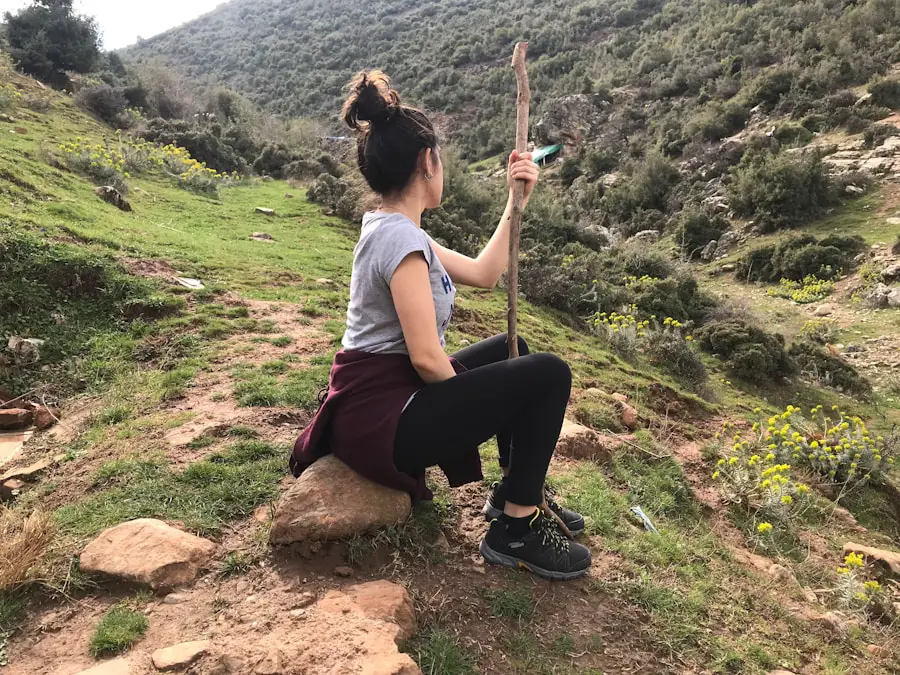Hiking poles, also known as trekking poles, have become an essential accessory for many outdoor enthusiasts. These poles are designed to provide stability and support while traversing various terrains, from rocky paths to steep inclines. The concept of using poles for hiking is not new; they have been utilized in various forms for centuries, particularly in mountainous regions where the terrain can be treacherous.
Modern hiking poles are typically made from lightweight materials such as aluminum or carbon fiber, making them easy to carry without adding significant weight to a hiker’s pack. The mechanics of hiking poles are straightforward yet effective. When used correctly, they can help distribute weight more evenly across the body, reducing strain on the knees and joints.
This is particularly beneficial during descents, where the impact on the knees can be substantial. Additionally, hiking poles can enhance balance, allowing hikers to navigate uneven surfaces with greater confidence. The adjustable length of many trekking poles also allows users to customize their height for optimal comfort and efficiency, adapting to different terrains and personal preferences.
Key Takeaways
- Hiking poles can provide stability, support, and balance while hiking on various terrains
- Bringing hiking poles on the trail can reduce strain on the knees and joints, increase endurance, and improve posture
- Potential drawbacks of using hiking poles include the added weight and the need for proper technique to avoid injury
- When choosing hiking poles, consider the material, weight, grip, and adjustability to suit your hiking needs
- Etiquette when using hiking poles on the trail includes yielding to uphill hikers, using rubber tips to minimize impact, and being mindful of others around you
Benefits of bringing hiking poles on the trail
The advantages of using hiking poles extend beyond mere stability. One of the most significant benefits is the reduction of fatigue during long hikes. By engaging the upper body, hikers can share the workload between their legs and arms, which can lead to less overall strain and increased endurance.
This is particularly advantageous on extended treks where maintaining energy levels is crucial for completing the journey. Studies have shown that using trekking poles can decrease the perceived exertion level, allowing hikers to cover greater distances with less effort. Moreover, hiking poles can serve as a valuable tool for navigation and exploration.
They can be used to probe the ground ahead for hidden obstacles, such as rocks or holes, which can be especially useful in dense underbrush or unfamiliar terrain. In addition, they can help clear away debris or snow from trails, making the path safer for both the user and fellow hikers. The versatility of hiking poles also extends to their use in various outdoor activities beyond hiking, such as snowshoeing or cross-country skiing, making them a multifunctional piece of gear.
Potential drawbacks of using hiking poles

Despite their numerous benefits, there are potential drawbacks to using hiking poles that hikers should consider. One common issue is the learning curve associated with their proper use. For those new to trekking poles, it may take time to develop an effective technique that maximizes their advantages while minimizing any potential drawbacks.
Improper use can lead to awkward movements that may cause discomfort or even injury. For instance, if a hiker relies too heavily on the poles without maintaining proper posture, it can lead to back strain or shoulder discomfort. Another consideration is the additional weight and bulk that hiking poles can add to a pack.
While modern trekking poles are designed to be lightweight, they still represent an extra item that must be carried. For minimalist hikers or those who prefer to travel light, this added weight may be a deterrent. Additionally, there are situations where hiking poles may not be practical, such as when navigating narrow trails or climbing steep sections where hands are needed for balance and support.
Tips for choosing the right hiking poles
| Factors to Consider | Importance |
|---|---|
| Material | High |
| Weight | High |
| Grip Type | Medium |
| Adjustability | High |
| Shock Absorption | Medium |
| Price | Low |
Selecting the right hiking poles involves considering several factors that align with individual needs and preferences. First and foremost, hikers should evaluate the material of the poles. Aluminum poles are generally more durable and less expensive but tend to be heavier than their carbon fiber counterparts.
Carbon fiber poles are lighter and absorb shock better but can be more fragile and costly. Depending on the type of hiking one plans to do—whether it’s day hikes or multi-day backpacking trips—this choice can significantly impact comfort and performance. Another critical aspect is adjustability.
Many trekking poles come with adjustable lengths, allowing users to customize them based on their height and the terrain they are navigating. A good rule of thumb is to set the pole length so that when standing upright with the pole in hand, the elbow forms a 90-degree angle. Additionally, features such as ergonomic grips and wrist straps can enhance comfort during long hikes.
Hikers should also consider the type of tips on the poles; rubber tips are ideal for hard surfaces, while carbide tips provide better traction on rocky or uneven ground.
Etiquette when using hiking poles on the trail
Hiking etiquette is essential for ensuring a positive experience for all trail users. When using hiking poles, it is crucial to be mindful of other hikers and maintain a safe distance from them. This is particularly important on narrow trails where space is limited; swinging poles too widely can inadvertently strike another hiker or create an unsafe situation.
Additionally, when approaching others from behind, it’s courteous to announce your presence before passing them to avoid startling them. Another aspect of trail etiquette involves being aware of your surroundings and adjusting your pace accordingly. If you are hiking with trekking poles and encounter a steep incline or a particularly challenging section of trail, it may be wise to slow down or step aside to allow faster hikers to pass.
This consideration fosters a sense of community among trail users and helps maintain a friendly atmosphere on the trail.
Alternatives to hiking poles

While hiking poles offer numerous benefits, they are not the only option available for enhancing stability and support on the trail. One alternative is using a walking stick or staff, which can provide similar advantages without the complexity of adjustable features or multiple components. A sturdy walking stick can be fashioned from a branch found along the trail or purchased as a single-piece tool designed specifically for hiking.
Another option is utilizing natural features of the environment for support. For instance, hikers can use trees or large rocks as handholds when navigating steep sections or uneven terrain. This method requires more awareness of one’s surroundings but can be effective in certain situations.
Additionally, some hikers may prefer to focus on building strength and balance through training rather than relying on external aids like poles.
Regulations and restrictions for hiking poles on different trails
When planning a hike, it’s essential to be aware of any regulations or restrictions regarding the use of hiking poles on specific trails. Some national parks or protected areas may have guidelines that limit or prohibit their use in certain regions due to environmental concerns or trail preservation efforts. For example, in sensitive ecosystems where vegetation is fragile, using trekking poles could contribute to soil erosion or damage plant life.
Before embarking on a hike, it’s advisable to check with local authorities or park services regarding any specific rules related to hiking equipment. This information can often be found on official websites or through visitor centers at trailheads. Understanding these regulations not only helps protect natural resources but also ensures that hikers remain compliant with local laws and guidelines.
How to properly use and maintain hiking poles
To maximize the benefits of hiking poles, proper usage techniques should be employed throughout a hike. When walking uphill, it’s beneficial to plant the poles ahead of you at an angle that allows for a natural arm swing while maintaining balance. Conversely, when descending, hikers should lower their bodies slightly and use the poles to gauge footing while distributing weight away from the knees.
Maintenance of hiking poles is equally important for ensuring longevity and performance. After each hike, it’s advisable to clean the tips and shafts to remove dirt and debris that could cause wear over time. Regularly checking for any signs of damage—such as cracks in carbon fiber poles or bent aluminum shafts—can prevent accidents during future hikes.
Additionally, lubricating locking mechanisms and ensuring that grips remain secure will enhance usability and comfort during outdoor adventures. In conclusion, understanding how to effectively use hiking poles can significantly enhance your outdoor experience by providing stability and reducing fatigue while navigating various terrains. By considering their benefits and drawbacks, selecting appropriate equipment, adhering to trail etiquette, and maintaining your gear properly, you can make informed decisions that contribute positively to your hiking adventures.
If you are planning a hiking trip and wondering if you can carry on hiking poles, you may also be interested in learning about the best time to travel to Korea. Check out this seasonal guide to help you plan your trip accordingly. Understanding the weather patterns and seasons can greatly enhance your hiking experience in Korea.
FAQs
What are hiking poles?
Hiking poles are lightweight, adjustable poles used by hikers to provide stability and support while walking on various terrains.
Can I carry on hiking poles on a plane?
Yes, you can carry on hiking poles on a plane. However, it’s important to check with the airline beforehand as some may have specific guidelines for carrying on hiking poles.
Are there any restrictions on carrying hiking poles in certain areas or trails?
Some national parks and trails may have restrictions on the use of hiking poles, especially if they have pointed tips that can cause damage to the environment. It’s important to check the rules and regulations of the specific area or trail before bringing hiking poles.
How do I pack hiking poles for travel?
Hiking poles can be collapsed or disassembled for easy packing. Many hiking poles come with a carrying case or can be secured to the outside of a backpack.
Are there any safety considerations when using hiking poles?
It’s important to use hiking poles properly to avoid injury. Make sure the poles are adjusted to the correct height, and use the wrist straps to prevent dropping them. Additionally, be mindful of where you place the poles to avoid tripping yourself or others.
